Conferences are exhausting things, and I'm tempted to give Wheel of Star Formation (a.k.a. JanFest) its own post. The unofficial conference after-dinner party kept going until 2:30am, as it should, which meant surviving the final morning session was no small challenge. The end, when it eventually came, was a blessed mercy. I ran home as fast as my little legs would carry me and collapsed into a four-hour nap. And when I awoke, I was further rewarded to discover my paper was accepted for publication.
Coincidence ? I think not. That's okay, it means my talk couldn't have been that bad...
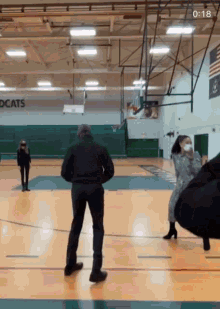 |
| NAILED IT. |
Now normally I have to go on a rant about how unpleasant the review process was. Not so here. This time, just for once, the reviewer was lovely. When they said they were "somewhat skeptical", they actually meant this literally, instead of it being code for, "I think you're a total idiot and I'm going to reject your paper because I don't understand it", which seems to have been my experience of the process one too many times. So today I shall go straight on with the science. And for that, I'll start by using the conference poster.
(But... beware. Even with the best will in the world, the result of this can't be said to be anything other than a big confusing mess. I'll try and wrap things up as cleanly as I can, but don't expect a nice neat narrative today, because there really isn't one.)
Introduction
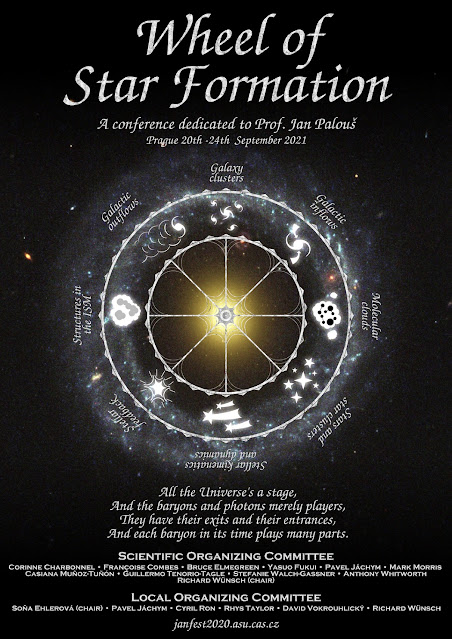 |
| I like this version of the poster best because all the dates are wrong. We started planning it in 2019, so the original 2020 date had to be postponed, and then the second date for 2021 also had to be delayed. Thanks, covid. |
The "wheel" concept was chosen as a theme because Jan lives in a converted water mill. And astronomers like to talk about the baryon cycle : how matter is converted between the different phases of stars and gas. The wheel here is an attempt to illustrate this, showing how gas is processed into stars, expelled, and re-accreted and processed by many different mechanisms in many different environments.
Where does my research fit in ? Regular readers already know of my obsession with gas clouds that don't do anything. After all, star formation is rubbish and a waste of precious neutral hydrogen gas, or, as I phrased it in the conference :
 |
| Basically the only connection of my talk to the wheel was that it was about the lack of a wheel. |
Actually, starless gas clouds are interesting because they're difficult to explain. The most mundane idea is that they're just torn off from regular, bright galaxies. A much more controversial prospect is that they're places where the wheel never started turning, galaxies in their own right where star formation never even got started. And no-one is sure if that's even possible. Some clouds have plenty of stars whereas others, which are otherwise indistinguishable, have none - and we really don't know why.
Normally I do a protracted introduction to the scientific background. Today I'm going to try something different and dive straight into the latest research, so let's see how that works. I'll say only in advance that the main survey I work on is called AGES, the Arecibo Galaxy Environment survey, which looks for atomic hydrogen gas with a great big radio telescope. Everything else I'll fill in as we go.
Everyone's Favourite Gassy Lion
Although my main interest lies in small gas clouds (here meaning "quite a bit smaller than the Milky Way"), I have to admit that the giant features are basically the porn of the radio astronomy world. You can't really not be impressed by features like the Magellanic Stream, spanning more than half the sky yet not even vaguely suspected to exist until the twentieth century.
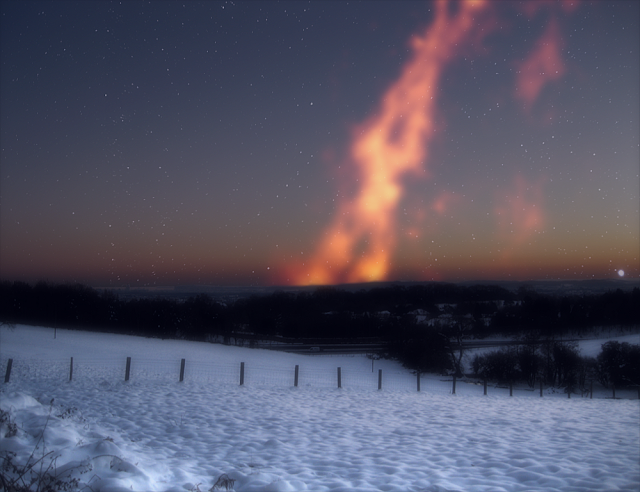 |
| Here shown as it would appear from Cardiff, were it visible to the eye. |
Well, I suppose you can be unimpressed, but then I'll look at you as though you have the same towering intellectual and spiritual capacity of a monkey that enjoys hurling its own faeces at other monkeys.
Anyway, the Leo Group harbours one such nerd-bonder-inducing feature : the Leo Ring. It's 200 kpc (650,000 light years) across and has a mass of gas of well over a billion Suns.
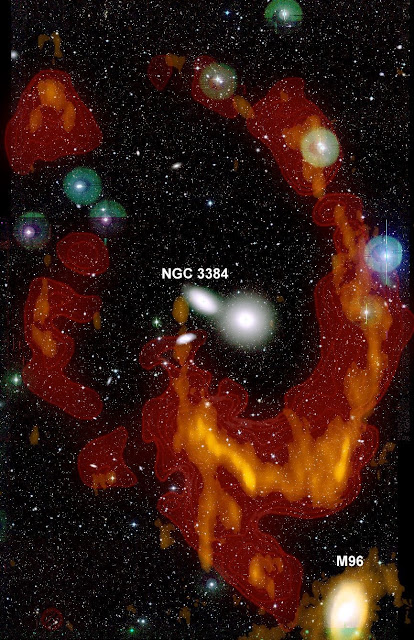 |
| The Ring itself (here shown from an earlier survey) isn't quite a gas cloud that isn't doing anything. Some evidence has been found that there is in fact star formation happening within it, at least in localised areas - though most of it remains dark. |
When you're planning a survey with extreme sensitivity, a region like this is a natural target field. I mean, can you think of any reasons not to do a survey of a giant gas ring with better sensitivity than any previous observations ? Of course you can't, because there aren't any.
Or somewhat more prosaically, the deeper the search, the more likely we are to reveal clues to its formation. Gas is never totally stable, and even once removed from a galaxy it can become dispersed or dissolved by a variety of processes. It might collapse under its own gravity to form stars (forming so-called "tidal dwarf galaxies"). Or it might be of such low density and high velocity dispersion that it simply flies apart, fading into undetectability. Or, it might be subject to ionising radiation and so change from nice, easily detectable neutral atomic hydrogen (which we can see with a radio telescope) into ionised gas (which we can't - or more accurately, requires totally different observing techniques).
But the Ring is not the subject of today's paper, not because it isn't awesome, but because we didn't find anything new that leaps out and says, "hey, look at this !". This isn't to say we found no new features in the Ring at all - we did, and some of them might be important. We just didn't find anything that adds anything of immediate value. So our focus on the Ring is now very much on numerical simulations, a project which is going to take a long while to bear fruit. We did, however, find something else that offers a much faster route to publication.
Six Little Clouds
That's right : not only does this region have the giant Ring, but it also has little gas clouds that don't do anything as well ! I could hardly ask for more. In fact I'd better go have a cold shower.
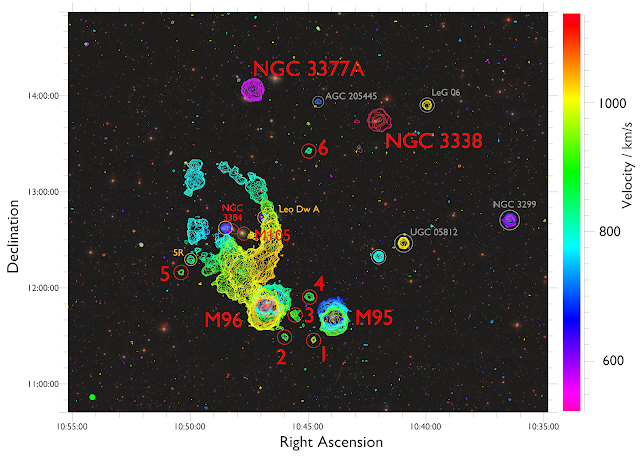 |
You can see an interactive 3D version of this here.
|
The really nice thing about radio observations like this is that we can measure what velocity the gas is moving at as well as how bright it is. That's what the colours of the contours show. It doesn't show the full data set though - we limited ourselves to a velocity range corresponding to everything that could plausibly be associated with the Leo Group in which the Ring resides. That's believed to be at a distance of about 11 Mpc (36 million light years).
There's quite a lot going on this plot but really it's pretty simple. The big red labels show the major galaxies and the clouds themselves. Other galaxies are highlighted with grey circles, really just to indicate that we catalogued them and haven't rudely ignored them - we need to know about them, but they're not important for this study. Similarly the orangey circles highlight features we use for a few comparisons but don't examine in any detail.
It's pretty hard to see on a plot of this scale, but every object apart from the six red circles (and 5R) has a clear, obvious optical counterpart. Much like Messier's "
not a comet" catalogue, for today's purposes, labelling these is really just to show everyone we know they're there.
Let's start with the six clouds that form our main sample. We can look at these in more detail :
The top row shows the contours on a pretty-picture optical view, the middle row shows the spectra, and the bottom row shows the optical view in a boring greyscale colour scheme that more clearly shows there's nothing there (with one exception).
In some ways the clouds are all quite similar. Their masses are all a few million times the mass of the Sun, and their line widths are all about 50 km/s. This is a measure of how fast the gas is moving around within the cloud along our line of sight, which we get from the spectra in the above plot. Spectra show how bright the emission is at any given velocity, with the line width meaning the difference between the emission at its highest and lowest velocities. Measuring this is easy enough, but interpreting its meaning - as we'll see - turns out to be quite subtle.
Going purely on where they are, an obvious thing to do would be to wave one's hands and declare clouds 1-4 to be tidal debris (they're right in between two massive spiral galaxies which could well be dukin' it out interacting with each other), cloud 5 to be part of the Ring, and cloud 6 to be a bit odd. And that might turn out to be not so very wide of the mark... but the full complexity is more interesting.
Six Not-Quite-So-Little Clouds
Even at the basic level the clouds are not as similar as they first appear. Cloud 1 has a line width quite a lot higher than the others, whereas cloud 5 is uniquely close to the Ring and quite a lot less massive than the rest. Clouds 1-4 seem to form a nice little population, but cloud 4 actually does have an optical counterpart.
Umm... but doesn't that mean it isn't a gas cloud that doesn't do anything ? And therefore really boring ?
Yes but no. In every other respect it's similar to the clouds : its mass and line width are typical, and it's found in close proximity to clouds 1-3 as well as being at very similar velocities. If you were given just the gas data, you'd never suspect it was any different to the other clouds. It's a great example of the situation I mentioned earlier, of having some clouds readily forming stars while others just don't.
(It's just about possible that the optical counterpart isn't actually associated with the gas : it could be at a different distance away from us. But if so, this would make it unique among the entire AGES sample so far. We have no other cases of optical counterparts found this close to the coordinates of the gas that didn't turn out to be associated.)
To figure out what's going on we need to dive a little deeper. Here's a zoom-in of the region where clouds 1-4 are found.
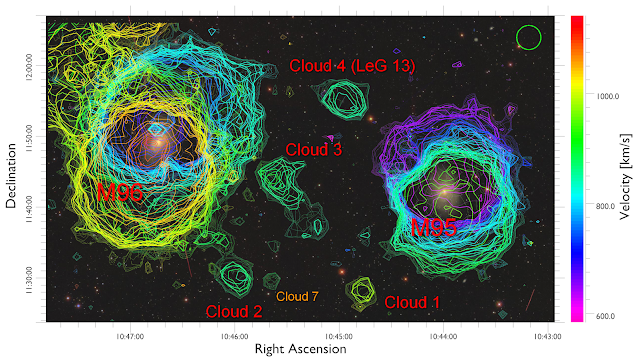 |
| Cloud 7 is a little blob that appeared after smoothing. It may or may not be real, we don't know. |
Notice here we have both thick and thin contours. The thin contours come from smoothing the data, which improves our sensitivity though at the cost of degrading our velocity resolution. This was a pretty neat trick (I think it was Robert Minchin who suggested this). See, while you can hand-wavily declare clouds 1-4 to likely be tidal debris, they don't really
look all that similar to the classic debris-structures.
Simulations have shown for
decades that this produces a characteristic tail and counter-tail on the parent galaxy, but that's just not what we're seeing here (in particular, M95 is pretty much undisturbed, apparently sailing serenely through the cosmic chaos raging all about it). And we also noticed that cloud 1 has that higher velocity width. So we thought that maybe if we smooth the cube in velocity, we might discover a larger, more... easily interpreted structure.
Well, we didn't. Why not ?
We don't know. The puzzling thing is that the smoothed contours are different to the standard ones, but not at all in the way we expected. With satisfying irony, the only cloud whose appearance isn't changed by the smoothing is cloud 1, the very one of which we were most expecting to see more extended features !
What actually happens is this. Cloud 1 looks unchanged, as do the big spiral galaxies M95 and M96. Cloud 2 appears to be connected to the spiral galaxy M96 by a narrow tendril, not much resembling a standard tidal feature. Cloud 3 is significantly more extended (some hints of that can be seen in the original data), while cloud 4 also shows some quite strong hints of being more extended as well. And while a new feature, tentatively but unimaginatively dubbed cloud 7, appears, there's absolutely no hint of any really large-scale bridge linking the two spirals, which would have been a "smoking gun" signature of a tidal encounter between them. Indeed, much of their outermost regions look completely unimpressed by everything that's going on around them.
 |
| Especially appropriate because dispersion is exactly what we'd expect. |
That cloud 4 is a bit more extended is a particular puzzle. We speculated that, being the most massive of the clouds (albeit only very marginally), maybe it was also the most compact and densest. Higher density means more star formation, but actually it looks like its density can't be much different to the others, and if anything is likely to be on the low side. So why is this one forming stars but the others are being a bunch of lazy buggers ?
Again, we don't know. Let's try a different approach.
Six... Totally Unique Little Clouds ?
Remember the line width ? For normal galaxies, this is basically equivalent to rotation speed (if you read the
previous post you'll know all about the subtleties of this). But remember, strictly speaking, this is not what it's really measuring. What it actually tells you is the difference between the lowest and highest line-of-sight velocities of a feature - that is, how fast each part is moving towards or away from us.
(Now to be really strict, distance and velocity aren't the same. In principle, a cloud detected at a velocity of, say, 100 km/s could be at a different distance of one moving at 101 km/s even if they were found at the exact same position on the sky. So in theory, each of these "six" clouds could actually be lots of clouds that had all just decided to line up very neatly along our line of sight. But this is fantastically unlikely bordering on silly : on large scales, distance does (famously !) correlate with velocity, so it's a very safe assumption that each of these clouds really is just one feature.)
Unfortunately we can't just simply assume line width represents rotation in all cases. For normal, star-filled galaxies this is a safe assumption, for the most part. There's a very neat relation between the "baryonic" mass (stars + gas) of a galaxy and its rotation speed. This is the Baryonic Tully-Fisher Relation :
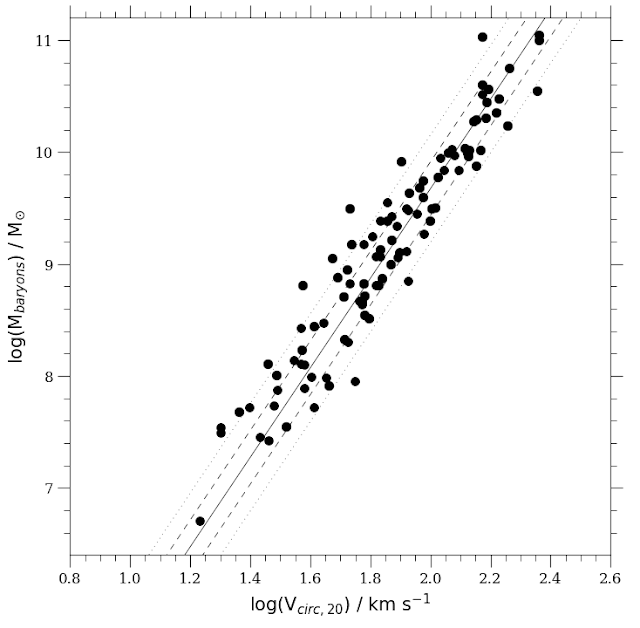 |
| I've simplified this just a tad, removing a few known and explicable outliers and combining a couple of different data sets. The axes are in logarithmic units, with the vertical one being mass and the horizontal one being rotation speed. Dotted and dashed lines show the scatter at different significance levels. |
This relation was found for observations which had much higher resolution than the AGES ones, where we can really see that one side of the galaxy is moving faster or slower than the other, giving us a true
rotation curve. With our data, we just have to assume the line width represents rotation. But take a moment to just marvel about bloody frickin' impressive this relation is : it holds for galaxies rotating from 15 to 250 km/s, ranging in mass from a few million to a
hundred billion times the mass of the Sun.
 |
| Opinion is divided as to whether this represents something inexplicable and impressive or monumentally dull, but either way, it's pretty neat. |
And then, take another moment to appreciate that making this plot requires a wheelbarrow full of work. I'll simplify here so people don't die of boredom, but if you want the full, grisly details, see the
previous post.
Right, are we all impressed enough yet ? Good. Let's continue.
Line width is definitely a good measure of rotation for normal galaxies, because we see the width gives a stonkingly similar location on the BTFR plot to true rotation velocity. When we then add in the dark clouds though :
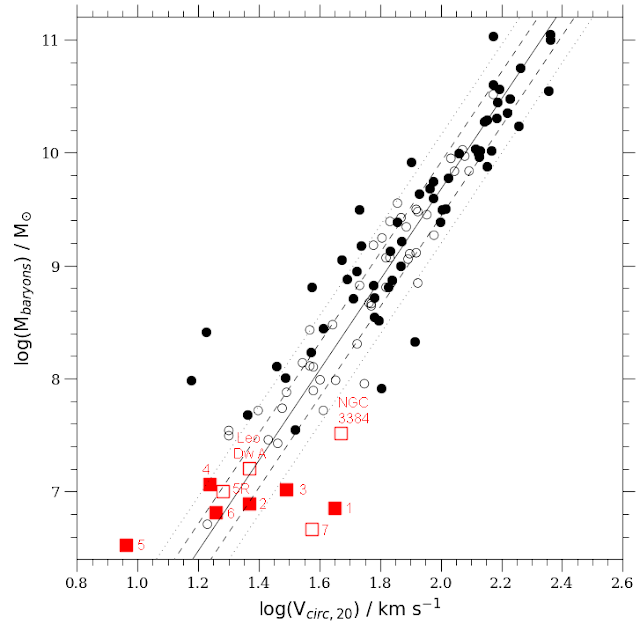 |
| Here I've split the galaxies back into their original samples : filled black circles show the data from AGES (now also including some outliers), while open black circles show ones with proper rotation curves. Red filled squares show the main Leo clouds while the open squares show other selected features in the same region. |
Which to be honest is not a lot of help, and maybe makes things if anything more confusing as to the clouds...
There's a very simple thing that might help to keep in mind as things about to get worse. Normal, rotating galaxies are proven to lie on the BTFR, with only rare exceptions. So something on the BTFR, naively, can be presumed to be a galaxy. Conversely, there's no reason at all to expect unstable, non-rotating bits of fluff to follow the BTFR, so anything not following the standard relation is more likely to be debris. Keep that in mind as your anchor point.
Let's take this one step at a time. Ignore everything else and have a look at clouds 1-3. Since these are right between the two big spirals, it seems a very good bet that they're tidal in origin, even if they don't look much like typical tidal features.
Now cloud 1 does seem to play ball. It lies well outside the general scatter of this BTFR: if this were rotation, it would be far higher than you'd expect for a galaxy of this mass - which would be absolutely consistent with it being unstable tidal debris that's in the process of dissolving. Hooray !
Except... maybe not. The thing is, cloud 1 is unresolved in our data, showing no signs of any extensions as we'd expect it to have if it was debris. But cloud 2, which does show such extensions, is in good agreement with the BTFR. So cloud 1's shape doesn't fit with a tidal origin, but its velocity does, whereas for cloud 2 it's the exact opposite. This is rather confusing.
Maybe this is just a bit of an odd fluke ? Well, let's try cloud 3 then... ahh, no help there. This one is much more debris-like after smoothing - it's the most extended of all - but though it too has a higher velocity width than the BTFR predicts, the difference is only marginal. It's by far the most extended but arguably still consistent with the general scatter in the BTFR.
Okay... cloud 4 ? Here things are a bit better. Having an optical counterpart and therefore quite probably just being a normal galaxy, this one agrees with the BTFR quite well. So that's something. And so does the very faint (but definitely a galaxy) Leo Dw A. Hooray ! The problem is that so does cloud 6, and also 5R (a feature most likely just part of the Ring), which don't have optical counterparts.
Now there's an exciting possibility for cloud 6 which I'll get back to soon. But if it's unstable debris, as cloud 5R almost certainly is, there's absolutely no reason to expect it to follow the same relations as for rotating stable galaxies. And some clouds known from other surveys (not shown here) also do the same thing.
In short, the clouds don't really match our expectations of the BTFR very well at all - they're not totally at variance with it, but they're not in great agreement either. The take away message is basically this :
Those other extra features (the open red squares) aren't any help either. Cloud 7 is offset, but we're not even sure if it's real, while the cloud near NGC 3384 (a big elliptical galaxy at the centre of the Ring) is somewhat deviant but likely has a lot of measurement errors, so its velocity width is probably overestimated.
Six Sensitive Little Clouds
Hang on, there could be an easy way of of this wretched mess. Forget the physics for a moment and try instead the statistics. What I mean is, we could be having an unpleasant attack of a selection effect.
It looks as though most features follow the BTFR or are only marginally offset. But maybe we only find clouds in this region of the BTFR because that's the only place we can find them, and they're just extreme examples of a population which is by and large normal. This is possible. After all, we do find a couple of clear outliers.
There's a few different effects at work here. For a cloud of any given mass, it's easier to detect if it has a smaller line width - all its flux is "bunched up" and appears brighter. Similarly at any given line width, clouds of higher masses are easier to detect. But at some point we expect the mass to be so high that we should have star formation*, so they'll no longer be optically dark. Fortunately we can quantify all this, and we find that...
* Strictly speaking it's density rather than mass that matters, but this is something we can account for.
There's really not much constraint on the clouds to be in this part of the BTFR at all. Bugger.
It turns out that we can easily detect clouds of the same mass with much wider widths than these, and other clouds are known which are a hundred times as massive and not forming stars. So width doesn't limit which ones we can detect, and the requirement that the clouds aren't star-forming doesn't impose any real constraint either.
Right. Okay. That didn't help at all then.
There is another caveat though. We've seen that interpreting line width can be complicated, but actually, measuring it isn't quite so straightforward either. It isn't like measuring the peak brightness - there isn't one unique width value that gives you the right answer. Instead we have to choose which conventionally-accepted procedure we want to adopt. Normally we measure the width at either half or a fifth of the peak brightness level, and there are calibrations we can apply to convert these values to true rotation speed. But naturally, this isn't perfect. And likewise, correcting the stellar mass of a galaxy is subject to a host of choices as to which method of converting brightness to mass one happens to prefer.
All this means that there is some considerable scope for shifting the best-fit line of the BTFR, as discussed in depth
previously. I'm only showing this particular version of the BTFR here because it's the best and most carefully-calibrated version, but it would be going a bit too far to pronounce it as definitive. In any case, we
could shift the line at least a little bit, changing which ones agree with the BTFR and which ones don't - but this is a pretty weak effect, and definitely doesn't solve everything.
Six Sexy Little Clouds ?
So let's presume this version is correct or we'll get nowhere. If statistics can't help us, it's time to bring in the physics.
For this, let's shift to cloud 6. This one is pretty much in the middle of nowhere. None of the galaxies near to it have signs of extensions, and they're anyway at such different velocities that they're likely at very different distances away from us. So it doesn't look anything like classical tidal debris, and its line width is consistent with being a perfectly normal galaxy on the BTFR... yet it has no visible stars.
Could this be one of the semi-mythical starless "dark galaxies" of song and story ? Such objects would solve a huge, long-standing problem in cosmology, that simulations predict far more galaxies than surveys detect. So this would be a Big Deal if this was the case.
The answer is... yes ! It could. Well, maybe. To be strictly accurate, I would phrase it thus : the dark galaxy hypothesis is a valid explanation that should not yet be rejected. I'd be willing to go a little further and say that it's hard to see how cloud 6 could have formed by tidal encounters, there being no obvious signs of any features that gave rise to it. The Leo Ring is miles and miles away, and it's damned hard to see what sort of event could create a giant, coherent, massive arc of material and also one teeny-tiny compact little blob that's so well-separated from it.
Of course this needs to be tempered. Without a full explanation of the formation of the Ring, we can't say for sure that it isn't just some weird outlying blob. Or we could look at it the other way around, and say that if we assume it is some outlying blob, this gives us a powerful constraint on the formation of the Ring. Either way, it's a valuable blob, to be sure.
If we can't reject the dark galaxy hypothesis for this cloud, what about the others ? Well, now I'm afraid I need to take the stabilisers off and contradict what I said earlier.
Just because something is deviant from the BTFR doesn't guarantee it's not a galaxy. There are known examples of very massive galaxies that
rotate too quickly, of very faint galaxies which
rotate too slowly, and we have good reasons to expect there to be
more scatter in the BTFR than we actually see.
And, if line width represents dispersion (i.e. expansion) instead of rotation, then the objects with the highest line width should be the hardest to detect because they'll become undetectable most quickly. This makes rotation (which implies dark matter) actually a much
better explanation in these cases, which is something I've previously shown
at length - with rotation, you can be stable at any velocity width indefinitely. For galaxies, the secret to immortality is just to spin round really fast.
 |
| Disclaimer : spinning yourself or your pets won't help you live longer. |
So alas, there's no clear, take-home message from this. The clouds simply don't fit a nice neat narrative, which is why the high-school description of science as a process of hypothesis testing is fundamentally flawed. Far better to remember that's a much more
complex network of exploration and examination. Depending on your point of view, you could easily present the data to favour or disfavour whatever you need it to.
With that in mind, here's how I'd sell it. It's my paper, after all.
Summary and Conclusions
These nice little clouds have similar masses and line widths, but even among this small population there's no small degree of complexity. Let's start with a summary of each of the clouds.
- Cloud 1 is between the two big spirals. It has much the largest velocity width, but smoothing didn't reveal it had any kind of extended component. Its location and line width suggest a tidal formation mechanism, but its lack of extension doesn't fit this view.
- Cloud 2 is between the two big spirals. It has a typical velocity width and smoothing reveals it has an extended "tendril" connecting it to one of the spirals. Its location and extension imply a tidal origin, but its agreement with the BTFR is unexpected, and its extension doesn't really fit the general expectation for tidal debris.
- Cloud 3 is between the two big spirals. It has a typical velocity width and smoothing reveals it is significantly extended, though not connected to either galaxy. It is marginally deviant from the BTFR, and generally just ambiguous all-round.
- Cloud 4 is between the two big spirals. It has a typical velocity width and is at a similar location to clouds 1-3, but uniquely has a clear optical counterpart. Its mass is only marginally greater than the others and smoothing reveals it may be slightly extended, so its density doesn't seem likely to explain why it alone has formed stars. It follows the BTFR of normal galaxies.
- Cloud 5 is close to the Ring, and it's hard to tell if this is really a discrete feature or not. Smoothing revealed no signs of anything extended.
- Cloud 6 is as isolated as anything can be in this region. It lies on the the BTFR for normal galaxies but, like the other clouds, has no optical counterpart. The galaxies nearest to it on the sky are actually likely to be at quite different distances, and none of them show signs of extensions anyway.
So the clouds differ in terms of their environment, line width, optical emission, and extension. Six clouds that vary in four different ways... that's so much diversity they're practically woke.
Now the optical counterpart to cloud 4 is clear enough, though it is quite faint. But thanks to the presence of the Ring, this region has been subject to a host of much, much deeper surveys, and none of them have reported anything at all at the positions of the other clouds. So if any of the other clouds do have optical counterparts, it's likely that they're an awful lot fainter. It's just not at all obvious why one cloud should be bright and the others aren't.
It's tempting to say that cloud 4 is a normal galaxy that just happens to have wandered in to the mess around it. That may be so. It could just be an innocent bystander that's wandered into a bad neighbourhood, and is going to get a nasty surprise when it realises some astronomers are gossiping about it behind its back.
But I'd say it's at least viable to say it might be a cloud that's had it's star formation triggered as it's wandered in - it looks so similar to the other clouds, it just seems weird to think this is a coincidence. Or perhaps the opposite is going on. Maybe it's not the first but the
last cloud to have had its star formation episode, with the others having
already faded into their current darkness. We really don't know.
With the clouds we found in an earlier AGES study of the Virgo cluster, we used their line widths to try and constrain their evolution, and we did the same here. If we assume the line width is how fast the clouds are dispersing, we can calculate how fast they'd have to have travelled to reach their current distance from their nearest galaxies while still being detectable. And in Virgo we found that this was so fast as to be really quite implausible.
Annoyingly the Leo clouds are on the margins. Their line widths aren't so high, so they wouldn't have had to have moved so fast. It would be quite a bit higher than expected in a group like this though, and that the clouds are at nearly identical velocities to the other galaxies speaks against this. But it's not a strong constraint, especially as we have no idea how fast anything is moving across the sky. In short, the line widths are consistent with the clouds being both tidal debris and dark galaxies, which isn't much use.
Here's my best guess. Clouds 1, 2, 3, 5 are all unusual forms of tidal debris, relating to the formation of the Leo Ring, with the bright spiral galaxy M95 not being involved at all. They may or may not be in a state just before or after a period of star formation, depending on whether cloud 4 is a normal galaxy or another cloud. Cloud 6 might be some long-lived tidal debris from some other, unrelated interaction, with the rest of its parent stream having already dispersed, though the possibility that it could be a dark galaxy needs to be given serious consideration.
The elephant in the room is that bloody great Ring, of course. It does seem to be connected to the spiral galaxy M96, but it almost looks like it's just superimposed, and doesn't represent any major damage done. And its overall structure is just frightening complex. Very plausibly, it involves five interacting giant galaxies, which means a parameter space which is hideously vast. Is it crucial or irrelevant ? We just don't know.
 |
| Humanity has a love-hate relationship with rings which is so powerful that it's literally mythical. |
So what're we going to do this figure this out ?
Oh, pish, y'all know the answer, it's a cliché even more entrenched than magical rings. Come on, all together now :
WE
NEED
MORE
DATA !!!!
In this case we're going to need more data from both observations and simulations. We need to figure out ways that stupid Ring could have formed, and then we need to test it all against observational data. Our clever tricks to increase the sensitivity have associated penalties, so really we just need better original data.
Without Arecibo this is hard. So my idea is to write to Jeff Bezos and pitch a sequel-prequel series : Radio Rings of Power. They're the size of galaxies and don't do anything, but I'm sure if we throw in enough sex and violence they executives will beat a path to our door. Stay tuned.














































